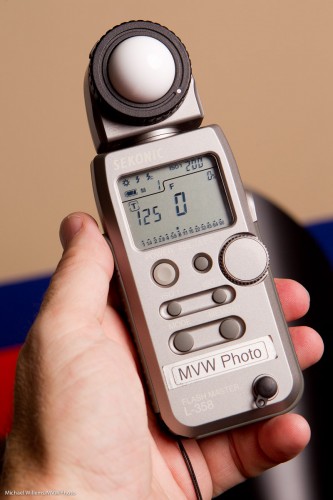…where “old” does not mean “outdated”.
I am talking about the light meter.
Some of you may think this is a tool that rusty old photographers used to use in the 1960s.
Not so. Modern, cool, young photographers like me (you are as young as you feel) use them too – every day.
The light meter is different from the light meter built into your camera:
- Unlike that camera meter, it is not a reflective light meter, but an incident light meter. It measures light falling onto your subject. Unlike your camera, which measures light reflected from the subject. So for the camera, the subject affects the measurement. A dark subject will reflect less, a light subject, more. So the camera will expose a dark-skinned person in a black suit differently from a light-skinned person in a white suit. And that is wrong: the camera should not care about the subject. Light is light. (Yes, true: keeping the exposure constant means that a dark subject will look darker than a light subject. But hey – that is exactly the way it should be!)
- Also, the modern light meter is a flash meter as well. It reads the bright pulses of light emanating from a strobe (or a speedlight set to manual). Which is exactly what the photographer uses it for.
- It is more accurate, sensitive, and quantitative. It can read light in stops or EV (exposure values), and it can read up to tenth of stops.
If you have never used a light meter, I urge you to start. When you shoot portraits, you have little choice, but even for outdoors light, and especially for mixed light, a meter will make your images’ exposure guaranteed good.
Use your mter as follows:
- Set the meter to the right mode (Flash, or ambient);
- Set the ISO to your camera’s ISO;
- Set the shutter speed to your camera’s shutter speed (e.g. 1/125th sec);
- Press the reset button, so the aperture displayed is zero;
- Hold the meter where your subject will be;
- Fire the flash;
- Read the value;
- Set that value on your camera.
You will not look back, once you get the hang of this excellent tool!


Can you recommend either a specific meter or at least the specs we should look for in getting an incident light meter for speed light work?
OK, so call me impatient. I’ve been thinking about getting a flash meter and your blog today fired me up (pun intended) to just do it. I’d been considering a Sekonic and found many comparisons online of the 308s and 358 models. I opted for the 358 (your model pictured) although the 308 would very likely have met my needs. My biggest reasons were: light meters last a long time so unlikely to have opportunity to upgrade if I wanted to; easier interface for ambient + flash exposure and flash ratios; wireless (for the future) capability; memory capability; best price for each one showed 358 only cost me $70 more. Thanks, as always, for inspiring me 🙂
Excellent choice. I just got home but would have recommended this meter.
Oh, my impatience wasn’t with you. It was more about getting a new gadget once I’d made the move (posting my question) in the direction of buying one! Thanks for all your great advice in this Blog. I’ve learned a lot.